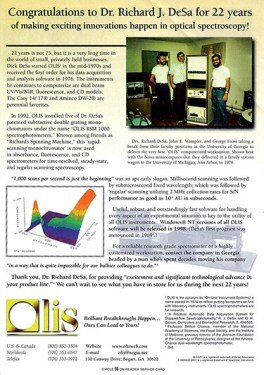Some Known Factual Statements About Spectrophotometers
Wiki Article
8 Simple Techniques For Spectrophotometers
Table of ContentsExamine This Report about Uv/visHow Uv/vis/nir can Save You Time, Stress, and Money.The 6-Second Trick For Circular DichroismHow Circularly Polarized Luminescence can Save You Time, Stress, and Money.Unknown Facts About Circular Dichroism

Spectrophotometry is a tool that hinges on the quantitative analysis of particles depending on how much light is taken in by colored compounds.
The 45-Second Trick For Uv/vis/nir
A spectrophotometer is frequently utilized for the measurement of transmittance or reflectance of options, transparent or opaque solids, such as sleek glass, or gases. Although many biochemicals are colored, as in, they take in noticeable light and therefore can be measured by colorimetric treatments, even colorless biochemicals can often be transformed to colored compounds ideal for chromogenic color-forming reactions to yield substances suitable for colorimetric analysis.: 65 However, they can likewise be created to determine the diffusivity on any of the noted light ranges that usually cover around 2002500 nm utilizing different controls and calibrations.An example of an experiment in which spectrophotometry is used is the determination of the stability constant of a solution. A certain chain reaction within a solution might happen in a forward and reverse direction, where reactants form items and products break down into reactants. At some time, this chemical response will reach a point of balance called a stability point.
Not known Incorrect Statements About Uv/vis/nir
The quantity of light that passes through the option is a sign of the concentration of particular chemicals that do not enable light to travel through. The absorption of light is because of the interaction of light with the electronic and vibrational modes of molecules. Each type of particle has a private set of energy levels connected with the makeup of its chemical bonds and nuclei and thus will absorb light of particular wavelengths, or energies, resulting in special spectral properties.
Making use of spectrophotometers covers different scientific fields, such as physics, materials science, chemistry, biochemistry. spectrophotometers, chemical engineering, and molecular biology. They are extensively used in lots of markets including semiconductors, laser and optical production, printing and forensic evaluation, along with in laboratories for the research study of chemical substances. Spectrophotometry is typically used in measurements of enzyme activities, determinations of protein concentrations, decisions of enzymatic kinetic constants, and measurements of ligand binding reactions.: 65 Ultimately, a spectrophotometer is able to figure out, depending upon the control or calibration, what substances exist in a target and exactly just how much through computations of observed wavelengths.
This would come as an option to the formerly produced spectrophotometers which were not able to take in the ultraviolet correctly.
The Ultimate Guide To Circularly Polarized Luminescence
It would be found that this did not provide satisfactory results, therefore in Design B, there was a shift from a glass to a quartz prism which permitted better absorbance results websites - UV/Vis (https://nowewyrazy.uw.edu.pl/profil). From there, Design C was born with a change to the wavelength resolution which wound up having three units of it producedIt was produced from 1941 to 1976 where the cost for it in 1941 was US$723 (far-UV devices were an alternative at additional expense). In the words of Nobel chemistry laureate Bruce Merrifield, it was "most likely the most essential instrument ever developed towards the advancement of bioscience." Once it ended up being terminated in 1976, Hewlett-Packard produced the very first commercially available diode-array spectrophotometer in 1979 called the HP 8450A. It irradiates the sample with polychromatic light which the sample absorbs depending upon its residential or commercial properties. Then it is transferred back by grating the photodiode variety which detects the wavelength region of the spectrum. Ever since, the creation and application of spectrophotometry devices has actually increased tremendously and has ended up being one of the most innovative instruments of our time.

Everything about Uv/vis/nir
Historically, spectrophotometers utilize a monochromator consisting of a diffraction grating to produce the analytical spectrum. The grating can either be movable or repaired. If a single detector, such as a photomultiplier tube or photodiode is used, the grating can be scanned step-by-step (scanning spectrophotometer) so that the detector can measure the light strength at each wavelength (which will represent each "action").In such systems, the grating is fixed and the strength of each wavelength of light is measured by a different detector in the selection. When making transmission measurements, the spectrophotometer quantitatively compares the portion of light that passes through a referral option and a test option, then digitally compares the strengths of the two signals and calculates the percentage of transmission of the sample compared to the recommendation standard.

Report this wiki page